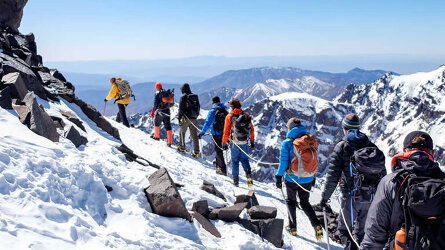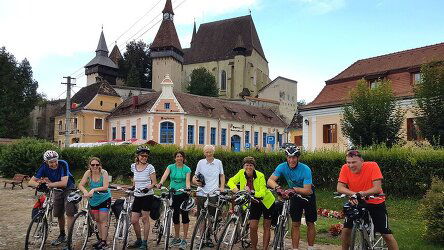Overview
Itinerary
Join the group in the early evening at the pension in Radovljica, just 20 minutes' northeast of the capital Ljubljana. This is our base for the week.
After breakfast, we leave the front door of the pension to explore our surroundings. The medieval town of Radovljica dates back as far as 1296, sitting on the confluence of the Sava Bohinjka and the Sava Dolinka. The old town is full of traditional inns, galleries, churches and surrounded by the largest medieval moats in the country.
The local area is extremely pretty, dotted with small churches, quaint villages, lush forests and a beautiful river. Our leader will decide the exact route depending on the weather, but walking to Lake Bled is our most likely route, a perfect warm up through gentle rolling farmland and pretty villages (B/D).
Starting at the small village of Gozd Martuljek, we are rewarded with a panorama of the Špik mountain range. One of the most beautiful mountains in the Julian Alps, Mount Špik (8,110/2,472m) is known at the Slovenian Matterhorn and its pyramid summit dominates the Martuljek range. Leaving the valley, our forest trail takes us into Martuljek Gorge, where we slowly start our ascent following the stream, arriving at the Lower Fall, which cascades into the valley.
The trail snakes through the forest arriving at our rest stop where we can enjoy the view. Lipovceva Hut has a lovely setting with an open natural kitchen serving mountain soups and juices made in-house from pine, elderflower and berries. From here we head up to the Higher Falls, passing a monument dedicated to Slovenian climbers. This is a lovely walk into the gorge, suitable in all weathers and offering fine views of two beautiful waterfalls (B).
The Karavanke mountains are the natural and official border between central and western Europe and the meeting point of Slovenia, Austria and Italy. The range has a great effect on the climate of Slovenia, hence the soft southern Slovene side in comparison to the harsh northern side in Austria. Here we find an abundance of alpine fauna and flora, with more than 1,200 plant species, plus wonderful views into two naturally contrasting countries. We aim for Golica (6,023ft/1,836m), part of the longest ridge in Slovenia (75mi/120km) and one of the least travelled trails in the area.
Radovljica itself has plenty of possibilities for the rest day. Alternatively, it's a short bus ride to Lake Bled, where we can hire rowing boats and canoes to explore. Alternatively, take the public bus into the capital of Slovenia, Ljubljana. Another popular alternative is Postojna Cave Park, home to one of the largest cave systems in Europe (B).
Today's walk is flat but incredibly pretty. This circular route takes in the whole of Lake Bohinj and the pretty village of Ribcav Laz, home to the well-known church of St John the Baptist. There are open views all the way to Mount Triglav, the highest peak in Slovenia. Lake Bohinj is also surrounded by a ring of mountains so even though you are in the valley there is plenty to see. An alternative route today takes us through the Mostnica Gorge; this route is more likely if the weather is poor as it is less exposed (B).
The beautiful, forested area of Pokljuka, visible from Lake Bled, is stunning. Virtually uninhabited, it is home to alpine cows, rolling pastures, shepherd huts, forest trails and lovely open views of the surrounding peaks. Time stands still on Pokljuka, enabling wildflowers to flourish; the flora and fauna of the high plateau is unique to this area and bird life is abundant. There is a wide variety of trails with many possibilities for the day's hike. Our guide will determine the route based on the weather and the group's ability during the week (B/D).
Our tour ends after breakfast. We bid a fond farewell to our pension, which may well feel like a second home by now, and begin our return journey home (B).
Trip Inclusions
- Discover Triglav National Park and the Karavanke mountains
- Embark on varied walks over mountains and through forests
- Enjoy a free day to explore Lake Bled or historic Ljubljana
- Stay at a traditional 19th-century Alpine pension
- 7 Classic nights (Pension Kunstelj)
- Five days of walking, one free day
- Travel by private minibus
- Not recommended for those who suffer with vertigo
- All breakfasts and three dinners
- Itinerary and inclusions are subject to change
- Price is for land, cruise and internal flights as specified. Flights not specified are not included
- Altitude maximum: 6,020ft (1,835m); average: 3,280ft (1,000m)

Hit the trails with Exodus - from challenging peaks to leisurely coastal and countryside walks. Read more

Exodus chooses their Leaders carefully. Professional, dedicated and are passionate about sharing their home countries. Read more

Wherever possible, Exodus chooses properties that are locally owned and that reflect the area you are visiting. Read more
Trip Reviews (1) Most Recent 'Walking the Slovenian Alps' Reviews
Availability
A definite departure means minimum numbers have been reached for this departure to operate. Your Global Journeys Travel Advisor will check the availability of your departure date when you enquire. Additional savings may apply. We guarantee the lowest price in Australia. T&C’s apply.
Tour & cruises prices are per person. Prices shown have savings applied, are subject to availability and may be withdrawn at any time without notice. Pricing and trip details are correct at this point in time, however are subject to confirmation at the time of booking and are subject to change by Exodus. For cruise itineraries, cabin images are sourced from Exodus. These should be treated as indicative only. Cabin inclusions, upholsteries and room layout may differ to the image(s) shown depending on the ship selected and your sailing dates.









